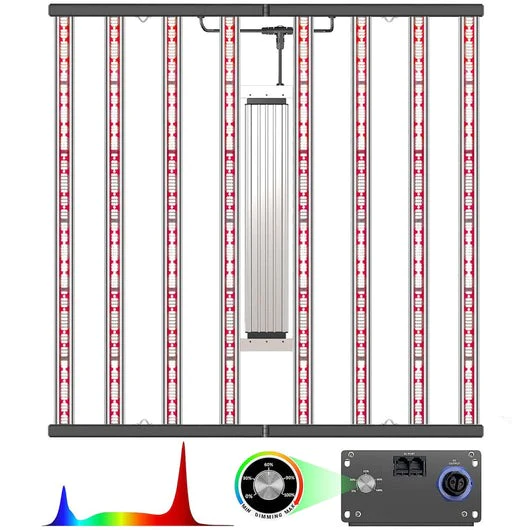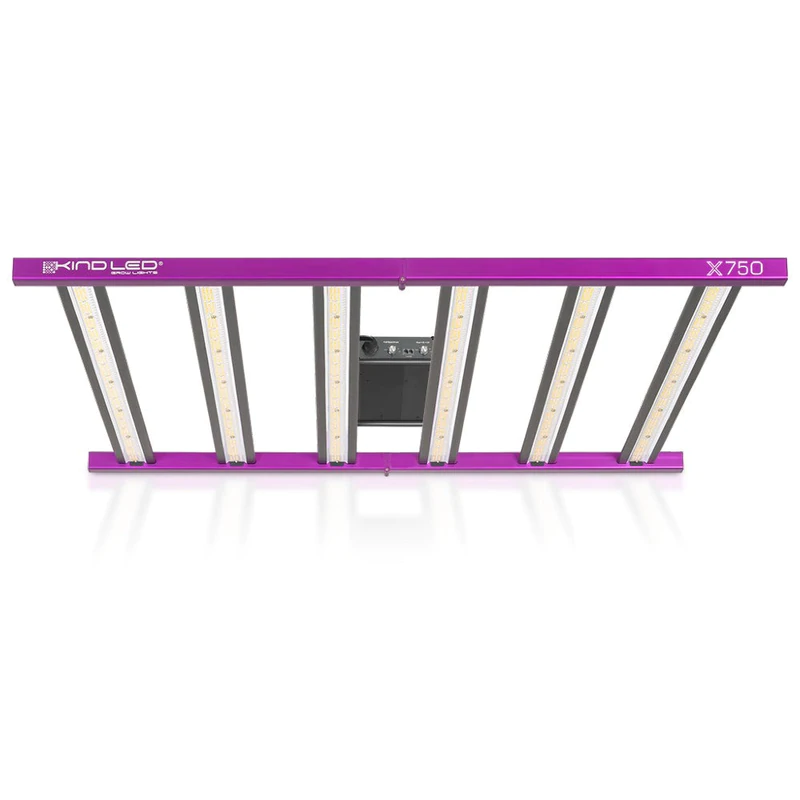Hyphotonflux PRO-720W Full Spectrum LED Grow Light VS Kind LED X750 Grow Light
Choosing the best LED grow lights for your grow tent is critical to the success of your indoor garden. Grow lights that are too small will not cover the entire grow tent, leaving some plants under-lit and stunting their growth. On the other hand, grow lights that are too large can generate too much heat and use too much energy, damaging the plants and increasing your electricity bills.
By choosing the right size LED grow lights for your grow tent, you can ensure all your plants get enough light without overheating your tent. This results in healthier plants, faster growth and higher yields. Therefore, when choosing one for your grow tent, careful consideration must be given to LED plant size, high light intensity, and other factors necessary to achieve the best results for your indoor garden.
Hyphotonflux PRO-720W Full Spectrum LED Grow Light

Features:
HYPHOTONFLUX LED Grow Light adopts SAMSUNG LM281B+Pro Top bin and 660nm deep red diodes (2784 in total). 720W of power delivers 2160μmol/s light output and achieves an unmatched 3.0μmol/J efficacy, completely beating 1000W HPS/MH grow lights. Full Spectrum 6500k White LED + Deep Red 660nm perfect for full cycle growth from seed to flower. Additionally, with an enhanced red spectrum, PRO-720 has better performance during flowering, making plants healthier and maximizing yield.

Features:
Kind LED grow light uses top-of-the-line Osram and Phillips diodes to produce targeted full-spectrum light as well as UV and IR to enhance your plants during flowering. The KIND X750 uses the full spectrum white LED diodes used by top LED companies. Kind’s Targeted Full Spectrum is designed for plants to maximize harvest weight and plant quality. Our spectrum is the result of hundreds of thousands of hours of field testing in the Northern California medicinal plant industry. With 750 watts of power and a 4' x 4' footprint, the X750 is powerful enough for commercial growers while still being compact enough for single planting.
Key Factors to Consider When Choosing LED Grow Lights
High efficacy and uniform PPFD
High Light Efficiency: High light efficiency LED grow lights convert electrical energy into usable light more efficiently. This efficiency is usually measured in lumens per watt (lm/W) or micromoles per joule (μmol/J). Therefore, choosing a plant growth light with high light efficiency can ensure that a greater part of the energy consumed is actually used by plants for photosynthesis. This improves energy efficiency, reduces electricity costs, and improves overall plant growth and yield.
Uniform PPFD Distribution: PPFD refers to the amount of light reaching a specific area within a grow tent. Uniform PPFD distribution means that light intensity is evenly distributed throughout the coverage area. This is important because plants need consistent light levels for balanced growth. If the PPFD is uneven, certain areas of the plant may receive more light, causing uneven growth and potentially affecting yield.
All spectra available
Spectrum plays an important role in all stages of plant growth (from seedling to flowering) and affects the overall health and productivity of the plant.
It is well known that different wavelengths of light have different effects on photosynthesis. Blue light (400–500nm) promotes vegetative growth, leaf development and compact plant structure. Red light (600–700nm) stimulates the flowering and fruiting process. Full-spectrum LED grow lights include a balanced combination of red, blue, and other wavelengths, including white, to provide a fuller spectrum that mimics natural sunlight. This ensures that your plants receive the necessary light energy during all growth stages.
In addition, chlorophyll, which is responsible for capturing light energy in plants, mainly absorbs light in the blue and red spectrum. By providing the right balance of blue and red light, LED grow lights can optimize chlorophyll absorption, enhance photosynthesis and promote healthy plant development.
Cooling Function
Heat dissipation is also a key factor for growers to consider. LED grow lights that generate too much heat can cause the temperature inside the grow tent to rise. High temperatures can stress plants, inhibit growth, and even cause damage. Effective heat dissipation therefore ensures that the lamp maintains a stable operating temperature, preventing overheating and minimizing negative effects on plant health.
Additionally, overheating can significantly reduce the lifespan and performance of your LED grow lights. Over time, prolonged exposure to high temperatures can degrade components and cause premature failure.
Conclusion
Because LED grow lights are designed to provide full-spectrum light, they provide a similar feeling to sunlight for plants inside a tent.
High-quality LED lights are a great investment for any indoor grower looking for the perfect alternative to natural light sources.
For optimal performance and a great return on investment at the end of each growing cycle, make sure you invest in the best grow lights.
In addition to the information provided in this guide, please don’t hesitate to do your own research before investing in any of the brands listed.
评论
发表评论